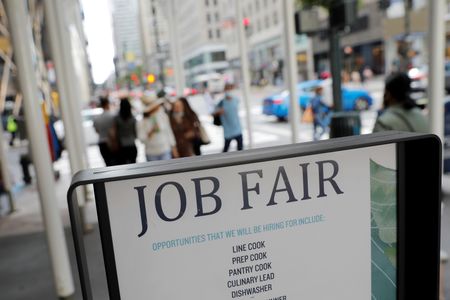By Lucia Mutikani
WASHINGTON (Reuters) – The number of Americans filing new claims for unemployment benefits fell last week, but annual revisions to the data showed applications were higher this year than initially thought, further evidence that the labor market was slowing.
With Thursday’s weekly jobless claims report, the Labor Department updated the methodology used to seasonally adjust the initial claims and the so-called continued claims data. Prior to the COVID-19 pandemic, the unemployment insurance claims series used multiplicative factors to seasonally adjust the data.
Beginning in March 2020 that was changed to additive factors, before switching back to multiplicative models as the large effects of the pandemic on the claims series lessened.
“For consistency, the published seasonal factors are presented as multiplicative with additive factors converted to implicit multiplicative factors and will not be subject to revision,” the department said in a statement. “Now that the pandemic impacts on the UI claims series are clearer, modifications have been made to the outlier sets in the seasonal adjustment models for both of the claims series.”
It said this approach had resulted in larger-than-usual revisions for many weeks over the last five years.
Initial claims for state unemployment benefits dropped 18,000 to a seasonally adjusted 228,000 for the week ended April 1. Data for the prior week was revised to show 48,000 more applications received than previously reported.
Economists polled by Reuters had forecast 200,000 claims for the latest week. The government revised the claims series from 2018. These revisions mostly showed claims increasing from mid-February of this year, aligning them with other indicators that have shown the labor market fraying around the edges.
“Our initial gut instinct is that the new seasonals may overstate the upward trend to some extent, but that they capture the direction of claims better than the old seasonals,” said Lou Crandall, chief economist at Wrightson ICAP. “Our early guess is that the 18,000 decline in the level for April 1 is a one-week fluke and that next week’s number will move back in the direction of the prior week’s level of 246,000.”
The government updated seasonal factors for 2023 and revised factors for 2018 through 2022. But it added that “the most volatile economic period of the pandemic, including the period running from March 2020 to June 2021, was not revised and will continue to be based on additive adjustments.”
Economists had viewed pandemic-related distortions to seasonal factors as one of several factors keeping claims low despite high-profile layoffs in the technology industry and some sectors particularly sensitive to interest rates
Stocks on Wall Street were trading higher. The dollar dipped against a basket of currencies. U.S. Treasury yields were mixed.
CREDIT CRUNCH
The labor market is expected to further loosen up in the second quarter as companies respond more to slowing demand triggered by the Federal Reserve’s interest rate increases.
Credit conditions have also tightened following the recent failure of two regional banks, which could make it harder for small businesses and households to access funding.
Small businesses, like restaurants and bars, have been the main drivers of job growth. Surveys from the Institute for Supply Management this week suggested that the labor market was fraying at the edges.
The Labor Department reported on Tuesday that job openings fell below 10 million at the end of February for first time in nearly two years. Still, there were 1.7 job openings for every unemployed person in February, which is making it easier for some laid-off workers to quickly find employment for now.
The number of people receiving benefits after an initial week of aid, a proxy for hiring, rose 6,000 to 1.823 million during the week ending March 25, the highest level since December 2021, the claims report showed. Continuing claims data for this year was also revised higher.
“What we’re seeing is probably some impact from severance packages running out from some of the bigger firms and also probably just some fatigue on the part of small businesses, which to this point really had been absorbing a lot of people who were being laid off,” said Thomas Simons, an economist at Jefferies in Bloomfield, New Jersey.
The claims data has no bearing on March’s employment report, which is scheduled to be released on Friday. Revisions, however, showed both initial and continuing claims were much higher than previously estimated during the week that the government surveyed businesses and households for the March report.
That poses downside risk to the estimate in a Reuters poll of economists for a gain of 239,000 in nonfarm payrolls last month. Wells Fargo lowered its estimate to 190,000 from 210,000. The economy created 311,000 in February. The unemployment rate is forecast to be unchanged at 3.6%.
Cooling labor market conditions could allow the Fed to halt its fastest interest rate hiking cycle since the 1980s.
The U.S. central bank last month raised its benchmark overnight interest rate by a quarter of a percentage point, but indicated it was on the verge of pausing further rate hikes due to financial market turmoil. The Fed has hiked its policy rate by 475 basis points since last March from the near-zero level to the current 4.75%-5.00% range.
Signs that the labor market was losing speed were underscored by a separate report on Thursday from global outplacement firm Challenger, Gray & Christmas that showed U.S.-based employers announced 89,703 job cuts in March, up 15% from February. Layoffs jumped 319% on a year-on-year basis last month and were concentrated in the technology industry.
GRAPHIC: Jobless claims and planned layoffs https://www.reuters.com/graphics/USA-STOCKS/dwpkdjdygvm/joblessclaims.png
Layoffs this year have been blamed on a range of factors, including market or economic conditions, cost-cutting, store or department closures as well as financial loss. Businesses also have had little desire to add workers.
(Reporting by Lucia Mutikani; Editing by Chizu Nomiyama and Paul Simao)





